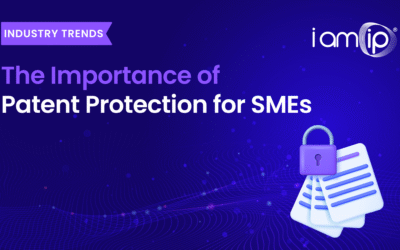
Patents remain one of the most powerful tools for protecting intellectual property. In 2025, with newly updated USPTO fees and stable EPO fees, it is important to know how long patents last, what they cost, and how to navigate the process efficiently.
Whether you’re a startup filing your first application or an enterprise expanding your IP portfolio, this guide walks you through the different types of patents, their lifespans and costs, including recent fee changes. It also includes practical tips to help you navigate the process and make cost-effective decisions.
What Are the Different Types of Patents?
In the U.S., the USPTO issues three main types of patents:
- Utility patents: Protect functional inventions like machines, processes, or chemical compositions. They last 20 years from filing and require maintenance fees.
- Design patents: Protect a product’s ornamental appearance, lasting 15 years from grant with no maintenance fees.
- Plant patents: Cover new, distinct asexually reproduced plants, lasting 20 years with maintenance fees like utility patents.
In Europe, the system differs:
- European patents: Granted by the EPO, covering technical inventions similar to U.S. utility patents.
- Unitary patent: A new type of patent providing uniform protection across participating EU member states with a single patent and renewal fees.
- National patents: Filed directly with individual national patent offices.
- Utility models: Available in some countries as simplified patent alternatives, but not via the EPO.
- Plant varieties: Protected by the Community Plant Variety Office (CPVO), separate from the EPO.
- Designs: Managed outside the EPO through national offices or the EU Intellectual Property Office (EUIPO) as Registered Community Designs.
How Long Do Patents Last?
Understanding patent duration is crucial for planning your IP strategy. Utility and plant patents both have a 20-year lifespan starting from the filing date, but they require maintenance fees to keep them enforceable. These fees are due at three key intervals, 3.5, 7.5, and 11.5 years for the U.S. after the patent is granted. Missing these payments can result in loss of patent protection.
Design patents differ, lasting 15 years from the grant date filings after May 2015, and they do not require maintenance fees. This makes design patents a cost-effective option for protecting product aesthetics without ongoing costs.
Unlike in the U.S., where maintenance fees are paid in only three intervals, European patents require yearly renewal fees starting from the third year after the filing date. These fees must be paid to the EPO while the application is pending, and after grant, they must be paid to the national patent offices of each country where the patent is validated.
What Do Patents Cost in 2025?
EPO
In 2025, filing a patent application through the European Patent Office (EPO) remains a common route for securing broad protection across multiple European countries. As of 2025, the EPO has announced that there will be no inflation-based fee increases this year, providing a stable cost environment for applicants. However, updates introduced in 2024 still apply. Understanding these fees is important for budgeting your IP strategy in Europe.
To file a European patent application, applicants must pay a basic filing fee of €135 (if filed online) and a search fee of €1,460. Once the application proceeds to examination, the examination fee is €1,840. If the total number of pages exceeds 35, a page fee of €17 per additional page applies, which can significantly increase costs for longer applications.
An additional claim fee is also charged for applications with more than 15 claims—€265 per extra claim beyond that threshold. These costs can add up quickly for more complex inventions with broader protection scope.
In addition to these upfront fees, renewal fees are due annually starting from the third year after the filing date. Recent updates from the EPO have significantly increased early renewal costs. For example, the third-year renewal fee has risen to €690 (up from €530), and the fourth-year fee is now €845 (up from €660). From the fifth year onwards, fees gradually increase each year, reaching over €2,000 by year ten. These changes were made to encourage earlier decisions on whether to maintain a patent application.
Overall, filing a European patent—from application to grant—typically costs between €5,000 and €10,000, excluding attorney fees and post-grant national validation costs. Once granted, additional translation, validation, and maintenance fees apply in each designated country, adding to the total cost of European protection.
These updates emphasize the importance of efficient filings and prioritizing markets where protection is truly needed. Strategic planning and collaboration with experienced patent attorneys can help applicants manage rising EPO costs effectively.
USPTO
Patent fees can vary widely based on the type of patent, complexity, and filing strategy. The USPTO has updated several fees in 2025, especially for complex filings and late-stage continuation applications.
For small entities, filing a utility or plant patent application now costs $350, while design patent filing fees are slightly lower at $300. Examination fees for utility patents can be as high as $2,880, depending on the complexity and number of claims.
If you’re considering international protection through the Patent Cooperation Treaty (PCT), you should expect additional costs. The PCT filing fee is $1,456, plus a $219 handling fee. Translation and local filing fees can exceed $10,000 per country, making international protection a significant investment. It’s wise to focus on countries where you plan to do business or enforce your patent rights to control costs.
Maintenance fees for utility and plant patents have also increased. Small entities must pay $1,000 at 3.5 years, $2,000 at 7.5 years, and $4,000 at 11.5 years to maintain their patents. Failing to pay these fees causes the patent to expire.
Attorney fees represent another large portion of patent costs. Preparing and prosecuting a utility patent typically ranges between $5,000 and $15,000, depending on complexity. Design patent attorney fees tend to be lower, usually between $1,500 and $3,000.
Additional USPTO fees apply if your application includes more than 20 claims or extra independent claims. For example, each claim over 20 costs $200, and extra independent claims beyond three are $600 each. Requests for continued examination (RCEs) are also costly, with the first RCE at $1,500 and subsequent ones at $2,860.
Late continuation applications submitted after 6 or 9 years come with hefty fees of $2,700 and $4,000 respectively, reflecting the USPTO’s push for efficient patent prosecution.
Filing Internationally: PCT and Beyond
If your goal is global patent protection, filing through the Patent Cooperation Treaty (PCT) streamlines the process by allowing one initial international application. However, it’s important to note that while the PCT application fees are substantial, the real costs often come with translation and local filing fees in each designated country.
Because expenses can quickly multiply, a good rule of thumb is to only file in countries where you have a clear business interest or plan to enforce your patent rights.
Prior Art Search: Ensure Novelty
Before investing heavily in patent prosecution, conducting a thorough prior art search is essential. This search identifies any existing inventions or publications similar to yours, ensuring your idea is truly novel. A professional prior art search typically costs between €500 and €5,000, while free DIY searches are available through USPTO and Google Patents, though they require more time and expertise.
A comprehensive prior art search helps avoid costly rejections and gives insight into the competitive landscape, ultimately saving time and money during examination.
What is Freedom to Operate (FTO)?
Freedom to Operate (FTO) analysis is critical for companies aiming to launch new products without infringing existing patents. This analysis examines whether your product or process might violate others’ patent rights, helping you avoid costly lawsuits or licensing fees.
An FTO analysis usually costs between €5,000 and €20,000, depending on scope and complexity. It involves a detailed patent clearance search combined with a legal opinion on potential risks. Many companies pair this with ongoing patent monitoring tools to stay updated on new patents that might impact their freedom to operate.
Smart Tips to Save on Patent Costs
With fees on the rise, managing your IP budget wisely is more important than ever. Here are a few strategies to reduce costs without sacrificing protection:
- Start with a provisional application (U.S. only) to delay major costs while securing an early filing date.
- Focus claims strategically to avoid excess claim fees and speed up examination.
- Bundle filings when applicable to reduce attorney fees and administrative overhead.
- Use professional prior art searches early to avoid costly rejections later.
- Choose target countries wisely for international filings—only file where you plan to commercialize or enforce.
- Use collaborative drafting tools and clear invention disclosures to reduce time spent with attorneys.
- Use IP management platforms to track deadlines and avoid late fees or lapses.
Final Thought
Understanding the true cost and lifespan of patents—whether in the U.S., Europe, or globally—is essential to any IP strategy in 2025. With rising fees, regional differences, and evolving filing options like the Unitary Patent, making informed decisions can save you significant time and money.
By combining clear planning, strategic filing, and the right digital tools, you can build a patent portfolio that not only protects your innovations but also stays efficient and cost-effective.
If you’re ready to optimize your patent process or expand internationally, partnering with experts and using advanced IP management solutions can help turn a complex journey into a smooth one.
Search
Categories
- Announcement 11
- Case Study 1
- Expert Insights 10
- IamIP News 6
- Industry Trends 30
- Innovation Index 4
- New Release 13
- Platform News 2
- Press Release 1
- Uncategorized 1
- Webinar 15









